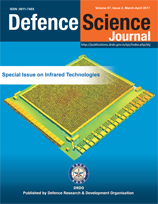Parasitic Flux Analysis of Cooled Infrared Detectors for Space Applications
DOI:
https://doi.org/10.14429/dsj.67.11180Keywords:
Parasitic flux, Long wave infrared, Integrated Detector, Imager, Stray light, Ray traceAbstract
An infrared imager measures radiations emitted by an object in specified spectral bands to determine change in object’s characteristics over a period of time. A typical infrared imager consists of focusing optics and a cryogenically cooled two-dimensional infrared detector array mounted on the cold tip of an active micro-cooler vacuum sealed with an optical window, typically known as integrated detector cooler assembly (IDCA). Detection of feeble radiant flux from the intended target in a narrow spectral band requires a highly sensitive low noise sensor array with high well capacity. However, in practical applications the performance of an infrared imager is limited by the parasitic thermal emissions from optical elements and emissions from IDCA components like vacuum window, Dewar walls which are generally kept at ambient temperature. To optimise the performance of imager it becomes imperative to estimate these parasitic fluxes and take corrective actions to minimise their effects. This paper explains an analytical model developed to estimate parasitic fluxes generated from different components of a long wave infrared imager. Validation of the developed model was carried out by simulations in ZEMAX optical design software using ray trace method after analytical computations in MATLAB.Downloads
Published
2017-03-14
How to Cite
Jain, A., & Biswas, A. (2017). Parasitic Flux Analysis of Cooled Infrared Detectors for Space Applications. Defence Science Journal, 67(2), 193–197. https://doi.org/10.14429/dsj.67.11180
Issue
Section
Special Issue Papers
License
 Where otherwise noted, the Articles on this site are licensed under Creative Commons License: CC Attribution-Noncommercial-No Derivative Works 2.5 India
Where otherwise noted, the Articles on this site are licensed under Creative Commons License: CC Attribution-Noncommercial-No Derivative Works 2.5 India


